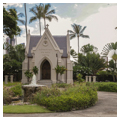Built in accordance with the dictates of King Lunalilo's will at the entrance of the Kawaiahao churchyard, this Gothic Revival mausoleum is one of the earliest concrete-block buildings in the United States. It follows a Greek cross plan, approximately eleven feet square at the crossing. Paired, diamond-paned, lancet windows adorn the three sides, and a gabled, Gothic-arched portico marks the entrance. The wrought-iron fence framing two sides of the grounds was manufactured in England.
King Kamehameha V, on his death bed, refused to name his cousin Lunalilo to succeed him, believing the man to be inept to rule the kingdom, thus precipitating the election which placed Lunalilo on the throne. Previously, in 1865, King Kamehameha V decided not to move Lunalilo's mother, Kekauluohi, a niece of Kamehameha I, from the aliʻi burial mound on the Iolani Palace grounds to the Kamehameha dynasty's royal mausoleum in Nuuanu. In response to this snub, Lunalilo vowed not to be buried in the royal mausoleum and instead asked to be laid to rest near his people. Charles Kanaina, Lunalilo's father, who died three years after his son, is also interred here.


















